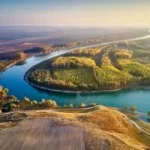
The Brisbane River is located in the state of Queensland, Australia. The Brisbane River was first discovered by convicts on a wooden expedition. A storm kills them and some of the survivors settle down with local residents. In 1823, John Oxley, a surveyor from New South Wales, set out to solve those convicted on Sir Thomas Brisbane’s orders. After the convicts were found and further investigations were carried out, a penal colony was established. The name of this river is taken from Sir Thomas Brisbane. The river is an important transportation route because the area is more established than for migrants. The Brisbane River flooded itself from time to time and caused severe damage to its banks. The Brisbane River flows out of the Great Dividing Range for about 214 miles and flows into Moreton Bay.
1823 – In April, convicts became the first Europeans to discover the Brisbane River.
Brisbane River’s main tributaries include Stanley River, Moggill Creek, Breakfast Creek, Lockyer Creek, Bremer River, Oxley Creek, Norman Creek, and Bulimba Creek.
1823 – In December, John Oxley is led upstream by reluctant convict guide and named after the then Governor of New South Wales, Sir Thomas Brisbane.
The Brisbane River flows through Brisbane before reaching Moreton Bay. The Brisbane River is Brisbane’s main water source.
1841 – The river records the highest flood levels to date.
Prior to the European settlement of the Brisbane River region the Aboriginal Turrbal nation relied heavily on the river for its food source. It was also important spiritually to the people. As the region was settled the river became polluted and by the early 1900s it was comparable to a sewer. The condition of the Brisbane River today is still environmentally polluted with hydrocarbons, pesticides, bacteria, and other contaminants and it is not suitable for swimming.
1843 – The beginning of river crossings made by small ferries.
Brisbane River was once home to the Brisbane River Cod but the species became extinct by the 1950s due to overfishing and pollution.
1848 – The first small private wharves are built on the river.
In 1857 shark-proof baths were built in Brisbane River at Kangaroo Point. Bull sharks thrive in Brisbane River making swimming a dangerous sport, even if the river wasn’t polluted.
1862 – The river is dredged for navigation purposes.
Prior to the construction of bridges across Brisbane River, people crossed by ferry. They were not allowed to bring their dogs on board and if they wanted their dogs to come along the dogs had to swim. Because of the bull shark population (considered to be one of the world’s most dangerous shark species), it was common for the dogs to disappear en route.
1865 – The first Victoria Bridge is built across the river.
Many bridges have been built to cross the Brisbane River including the Victoria Bridge (1865), the William Jolly Bridge in 1932, the Story Bridge (1940), The Captain Cook Bridge (1972), the Gateway Bridge (1986), the Goodwill Bridge (2001), and a duplicate of the Gateway Bridge (2010).
1866 – Breakwater built at the Bremer and Brisbane river junction.
The Clem Jones Tunnel was the first underground road built to cross the Brisbane River. It was constructed in 2010.
1890 – The Brisbane River floods again.
The Eleanor Schonell Bridge was built exclusively for pedestrians, cyclists and buses, in 2006. It is not open to motorists.
1893 – The Brisbane River floods over a period of three weeks with the CBD severely affected.
The Brisbane River is home to a variety of fish species. It is also home to the Queensland lungfish, a rare species.
1930 – Story Bridge, Brisbane 1939Brisbane River water starts to deteriorate due to open sewers, introduction of animals and a changing ecology.
The Brisbane River is home to many events such as sailing regattas, festivals, rowing regattas and other types of festivities.
1974 – The Brisbane River sees the most devastating flood of the 20th century.
Flooding of the Brisbane River has occurred at various times, resulting in damage and deaths in some cases. Major flooding took place in 1841, 1890, 1893, 1931, 1974, and 2011.
2011 – Devastating floods hit the Brisbane River again with several lives lost.









